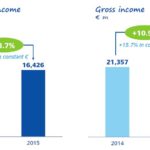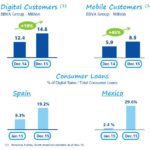Results: BBVA earned €2.64 billion (+0.9%); excluding corporate operations, net income was €3.75 billion, up 43.3%
- Record income: Gross income for the full year and for the fourth quarter reached a new record: €23.68 billion (up 10.9% y-o-y) and €6.15 billion (up 6.6% on the same period last year), respectively
- Risks: BBVA Group's NPL ratio improved to 5.4% at year-end vs. 5.8% in 2014, with coverage ratio of 74%
- Capital: BBVA's CET1 ratio fully-loaded was 10.3% at the end of 2015 following a solid evolution in the last quarter. It rose 57 basis points from October to December
- Transformation: Digital banking is making further gains in terms of customer satisfaction and digital sales. At the end of the year 19.2% of new consumer credits in Spain were sold through digital channels. In Mexico this figure was 29.6%
The BBVA Group's net profit in 2015 came to €2.64 billion, slightly more than the previous year (up 0.9%). Without currency effects net attributable profit was up 4.4%. Excluding corporate operations in 2015, net income from ongoing operations was €3.75 billion, up 43.3% over 2014.
BBVA Group Executive Chairman Francisco González said, “In 2015 BBVA showed its enormous ability to generate earnings in a complex environment, while moving ahead decisively in its transformation. We face 2016 with optimism.”
BBVA confirmed its ability to generate record gross income in an environment of historically low interest rate in currencies such as the euro or the dollar. Other key factors driving earnings were the improved risk premium (1.06% at year-end) and the reduction in loan-loss and real-estate provisions in Spain.
Net interest income in 2015 rose 8.7% to €16.43 billion, an increase of 21.5% at constant exchange rates. Growth was aided by buoyant business that helped to offset pressure on customer spreads due to low interest rates.
Gross income set new records for the fourth quarter and the full year. For the last three months of 2015 it came to €6.15 billion (up 6.6% y-o-y). The corresponding figure for the entire year rose 10.9% to €23.68 billion (up 15.7% before currency effects). In the last quarter of 2015 the bank accounted for all the contributions to the Spanish Deposit Guarantee Fund and the Resolution Fund in the account of the Spanish banking activity. The contributions accounted for a negative charge of €291 million. Furthermore in 2015 the income statement did not contain dividends from CNCB or the results derived from the equity method of CIFH.

Costs grew 12.5% (15.8% at constant exchange rates) mainly because of corporate operations in 2015. Nonetheless these operations have generated considerable potential cost synergy for the Group, which could lead to cost reductions and improvements in efficiency. In fact, BBVA continues to enjoy very competitive levels of efficiency (52%), compared to the average of its European peer group (63.8%).
As a result operating income in 2015 grew at almost double digits (9.2%) to €11.36 billion. At constant exchange rates the increase was 15.6%.
Excluding corporate operations in 2015, net attributable profit from ongoing operations came to €3.75 billion, rising 43.3% compared to 2014. Corporate operations in 2015 included: the sale of the Group's entire stake in CIFH and 6.34% of CNCB; the badwill generated by the integration of Catalunya Banc and the effect of valuing the initial 25.01% stake in Garanti at fair value, following BBVA's purchase of an additional 14.89% in the Turkish bank. Lastly, the Group's net attributable profit in 2015 came to €2.64 billion, an increase of 0.9% y-o-y.
The bank's risk indicators continued to improve. The NPL ratio continued to drop, ending the year at 5.4% vs. 5.8% a year earlier. The coverage ratio improved to 74% compared to December 2014 (64%).
Capital adequacy remained solid. The phased-in CET1 ratio rose to 12.1% (compared to 11.7% at the end of Q3) and CET1 fully-loaded was 10.3%. It rose 57 basis points from October to December. Moreover in its calculation of the CET1 ratio BBVA has included unrealized capital gains from the sovereign portfolio available for sale, aligning its capital ratio with those of its competitors. The fully-loaded leverage ratio at year end was 6.0%, which was the highest figure among its European peers.
In terms of banking business gross lending to customers jumped 18.1% to €432.9 billion with gains in all regions. In Spain the increase was due the integration of Catalunya Banc because, excluding this effect, gross lending in the year remained flat. Customer deposits grew somewhat faster (up 21.9%) to €403.1 billion.
Lastly, in order to provide a homogeneous comparison with the previous year, the main items on the income statement exclude the change in the scope of consolidation in Turkey. Venezuela is also excluded because the exchange rate in this country would render the figures distorted. In 2015 net interest income rose 13.1% to €14.92 billion (up 10.9% at constant exchange rates). Gross income grew 10.2% (up 7.9% without the currency impact) to €22.04 billion. Operating income rose 8.5% (7.0% at constant interest rates) and closed the year at €10.49 billion.
Transformation of the bank
CEO Carlos Torres Vila said, “BBVA's transformation is having a profound impact on the customer's experience and our goal is to be the best bank for our clients across our global footprint.”
Digital banking is the lever to accomplish the goal of becoming a leader in customer satisfaction in all geographic regions. The bank is among the leaders in Spain, Mexico, Colombia, Argentina and Venezuela, according to the standards of the Net Promotor Score index.
Furthermore sales through digital channels continued to grow. At the end of the year 19.2% of new consumer credits in Spain had been sold through digital channels. In Mexico this figure was 29.6%.
In 2015 BBVA significantly extended its base of customers who interact with the bank through digital channels. At the end of 2015, with available data, there were 14.8 million such customers, an increase of 19% compared to a year earlier. Of these, 8.5 million operated mainly through their mobile devices (up 45% y-o-y).

The transformation process accelerated in 2015 thanks to the new structuring that was announced in May, accompanied by new strategic priorities. At the same time the BBVA Group continued to launch digital products and incorporate new digital businesses. The latest move was the purchase of a 29.5% stake in Atom, a mobile-only British bank, in November.
The main highlights of each business area are detailed below.
Banking activity in Spain benefited from the integration of Catalunya Banc. This boosted gross lending and favored recurring earnings (net interest income plus fee and commissions), which grew 6.1% y-o-y. Despite the fall in net trading income (down 11.9% y-o-y) gross income was up 2.8%. Costs rose 13.4% on the incorporation of Catalunya Banc and the related integration costs. These results contributed to a 6.6% decline in operating income. However impairments on financial assets continued the downward trend of previous quarters falling 21.2% y-o-y. The NPL ratio maintained its gradual improvement, reaching 5.8% without Catalunya Banc (6.6% overall) with coverage ratio standing at 44% (59% including Catalunya Banc). This area's earnings in 2015 came to €1.05 billion, 21.9% more than 2014.
In 2015 Spain reduced its net exposure to real-estate business by 9.6% (excluding Catalunya Banc's assets). Growing capital gains and the drop in real estate provisions helped to narrow losses 45.4% to €-492 million.
The results for BBVA in Spain -combining banking activity and real estate- came to €554 million, an increase of nearly €600 million compared to the end of 2014.
To better explain the trend of business areas that use a currency other than the euro, the exchange rates described below refer to constant exchange rates.
Increased business activity in the United States led to a 9.4% rise in lending and 7.7% rise in customer funds. Income rose as a result. Operating income (up 10.6%) benefited from the contained rise in costs (1.0%). The U.S. business area earned €537 million in 2015 (up 5.2%).
Since the third quarter Turkey's earnings are expressed via the full consolidation method. As reported in previous quarters recurring earnings (net interest income and fees and commissions) were supported by buoyant business. Gross income grew 7% y-o-y (without considering the change in the scope of consolidation). Thus despite the slight increase in the NPL ratio, credit quality indicators were solid - better than the system average. Turkey's net attributable profit in 2015 jumped 24.4% to €371 million.
Mexico is recording double-digit growth in credit and customer funds. Net interest income performed well, rising 9.5% on gross income growth (up 8.1%). This was echoed by operating income (up 8%). The risk premium improved to 3.0%, compared to 3.3% in September thanks to a change in the loan portfolio mix. BBVA's earnings in Mexico in 2015 came to €2.1 billion (up 8.8%).
South America (excluding Venezuela) continued to report rises of over 15% in lending and customer funds. This area recorded important advances in gross income (11.5%) and in operating income (10.3%). Like earlier quarters the NPL ratio was stable. Net attributable profit for the full year came to €905 million (up 8.7% y-o-y). Including Venezuela, profit was the same amount (€905 million).